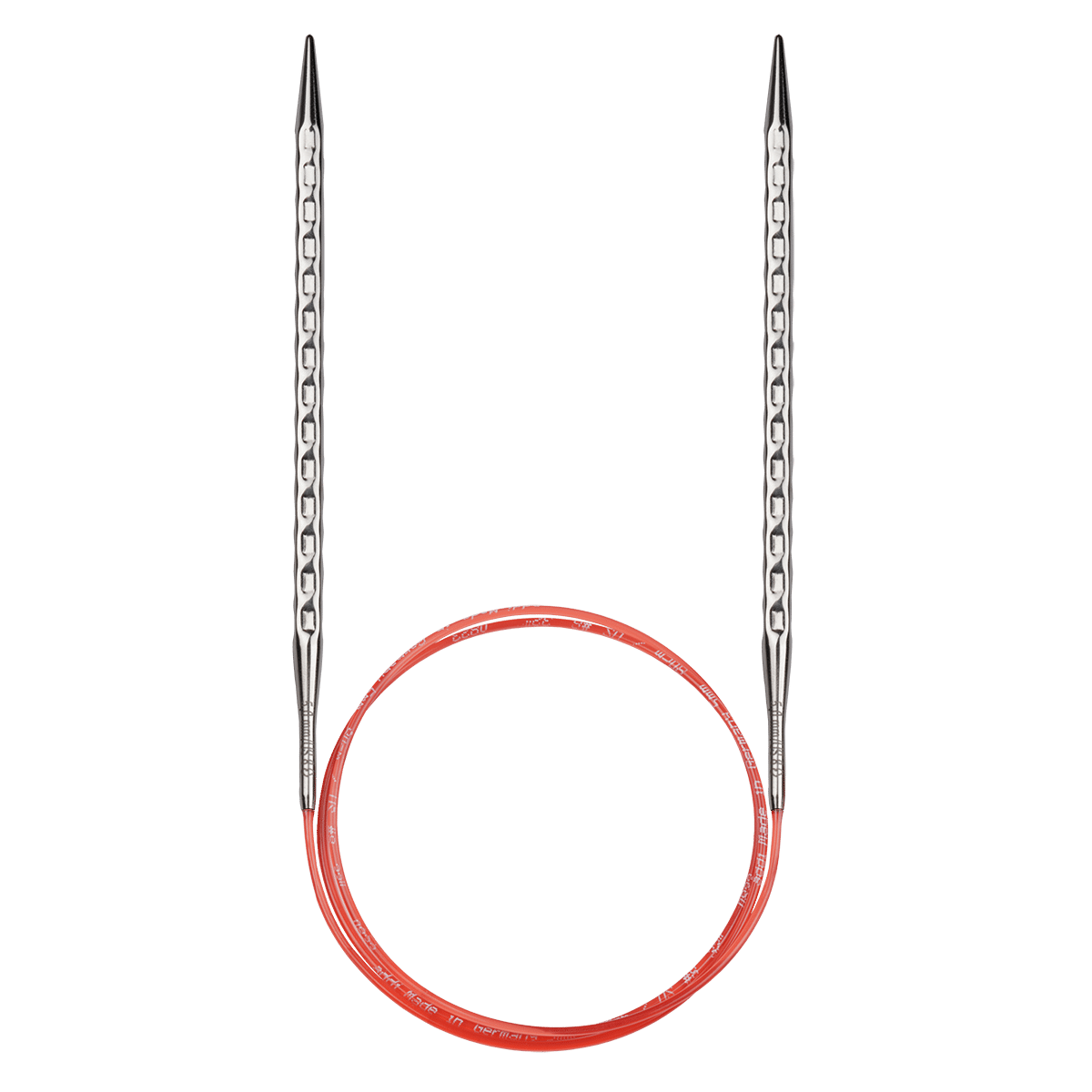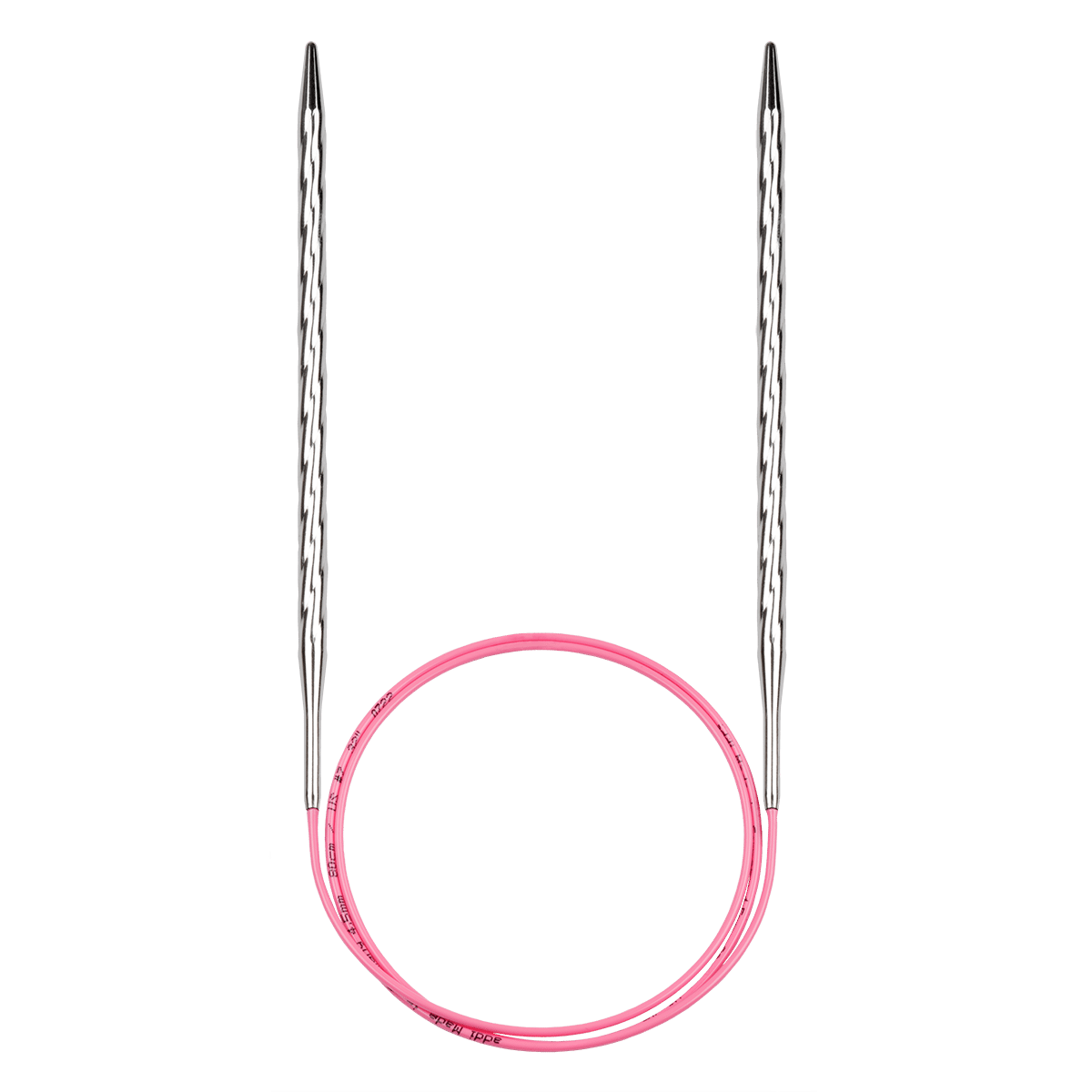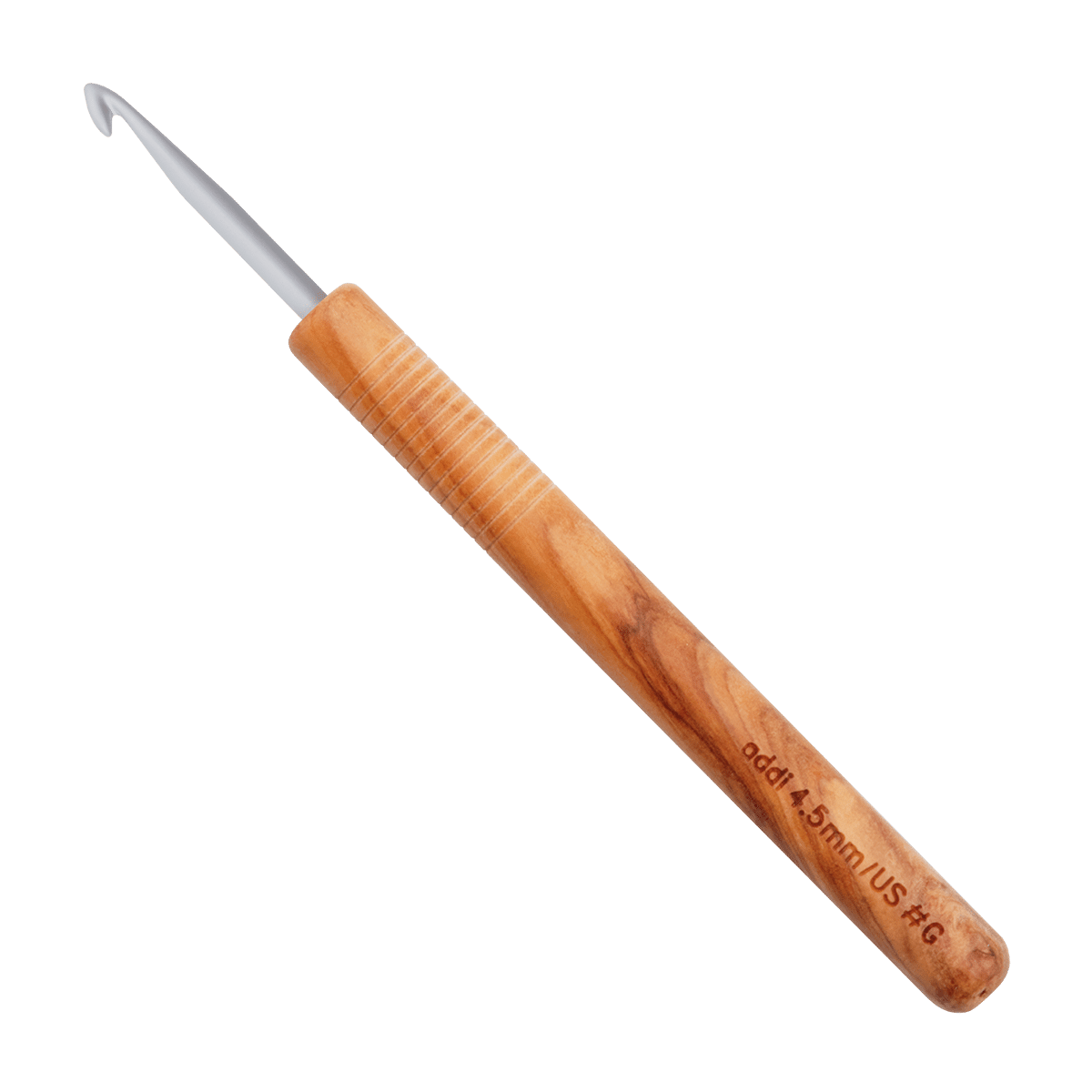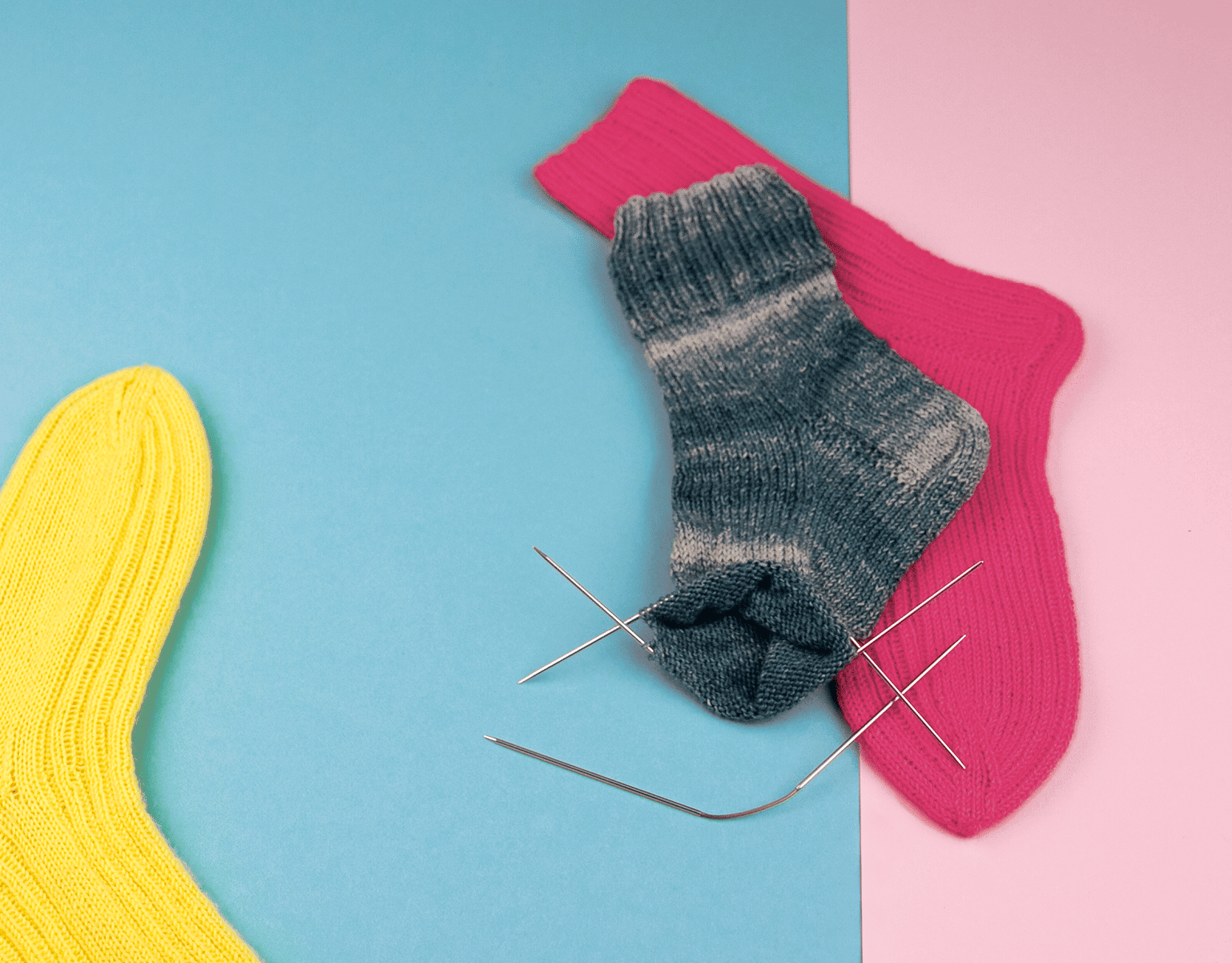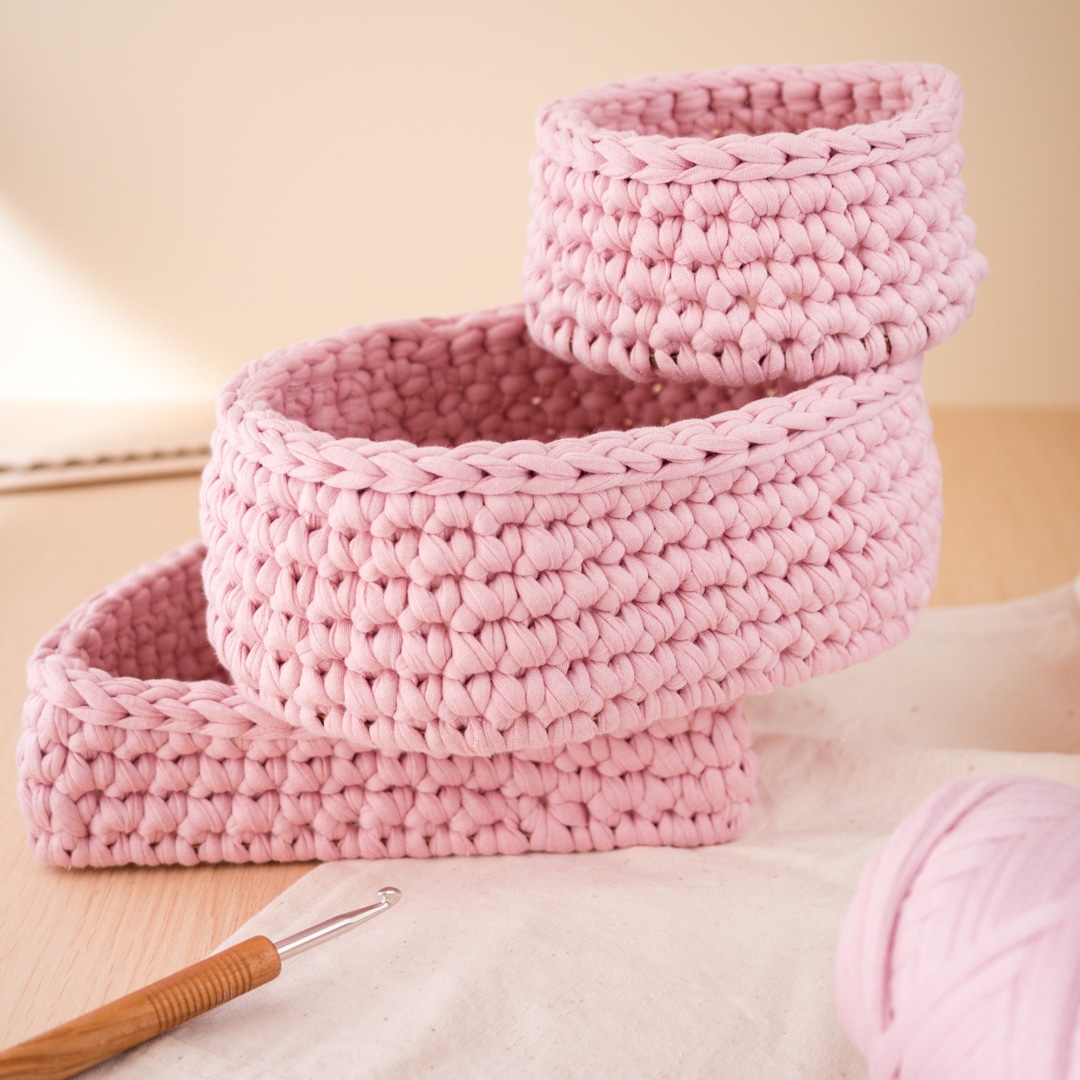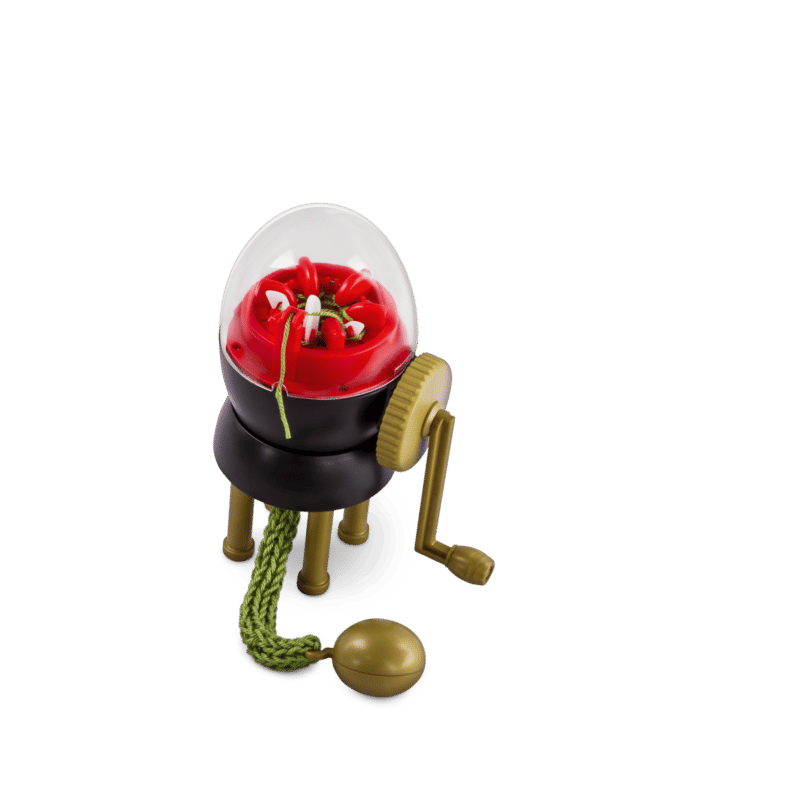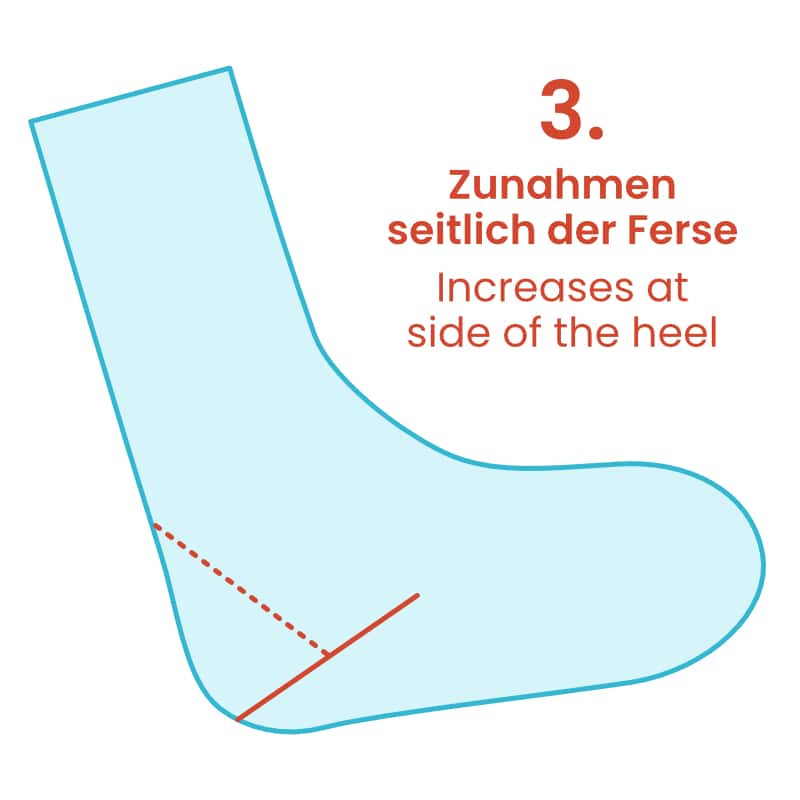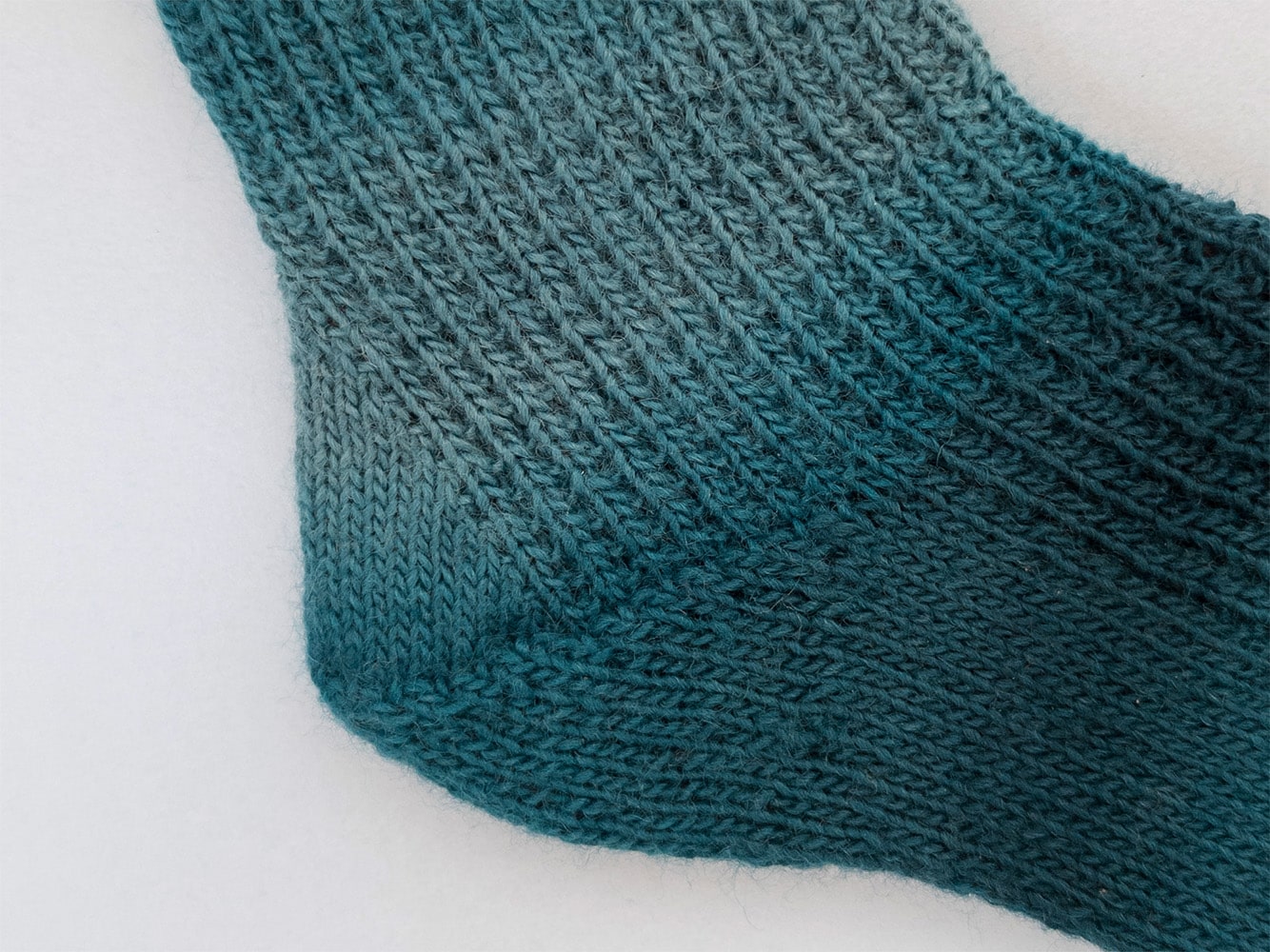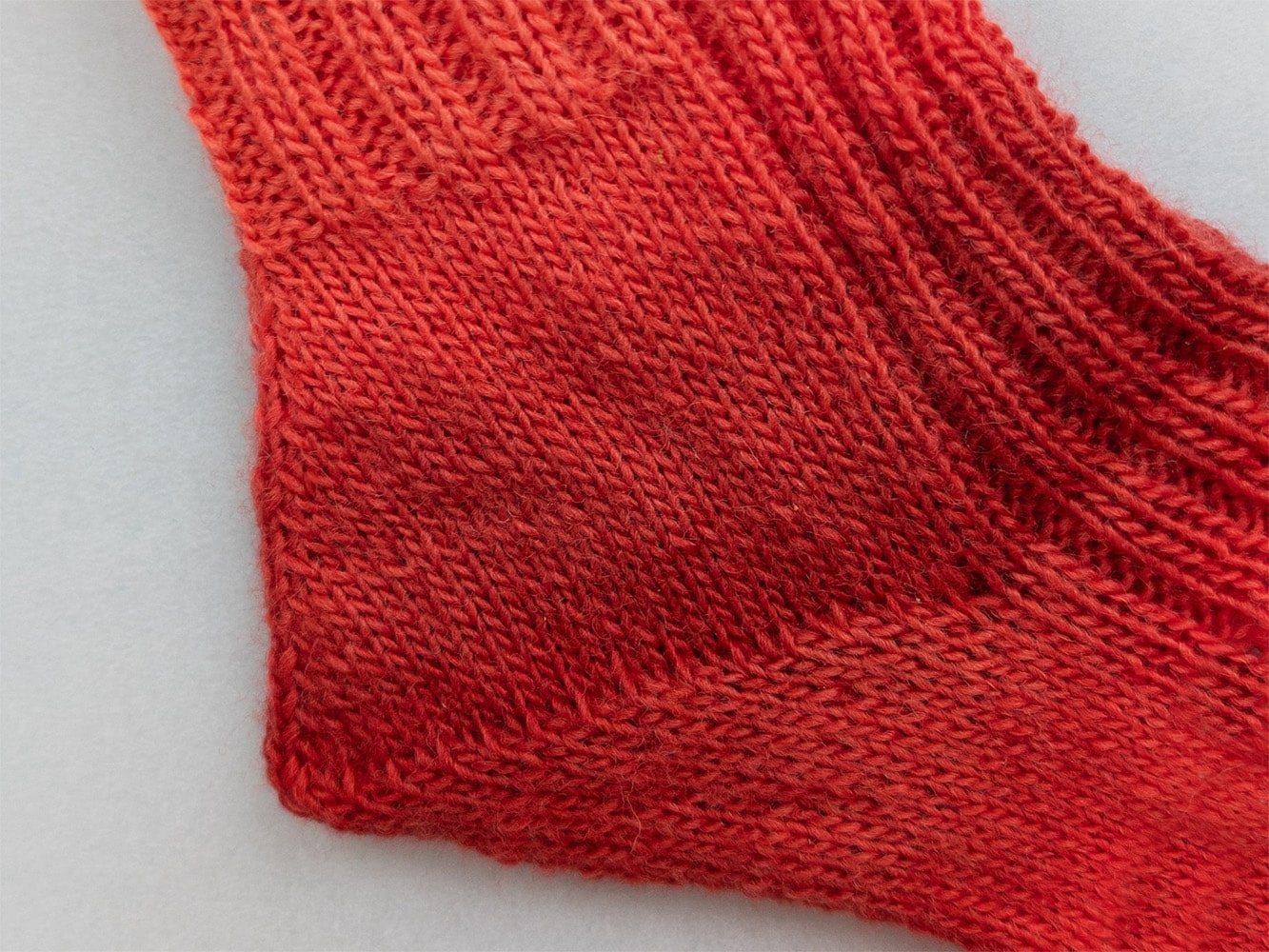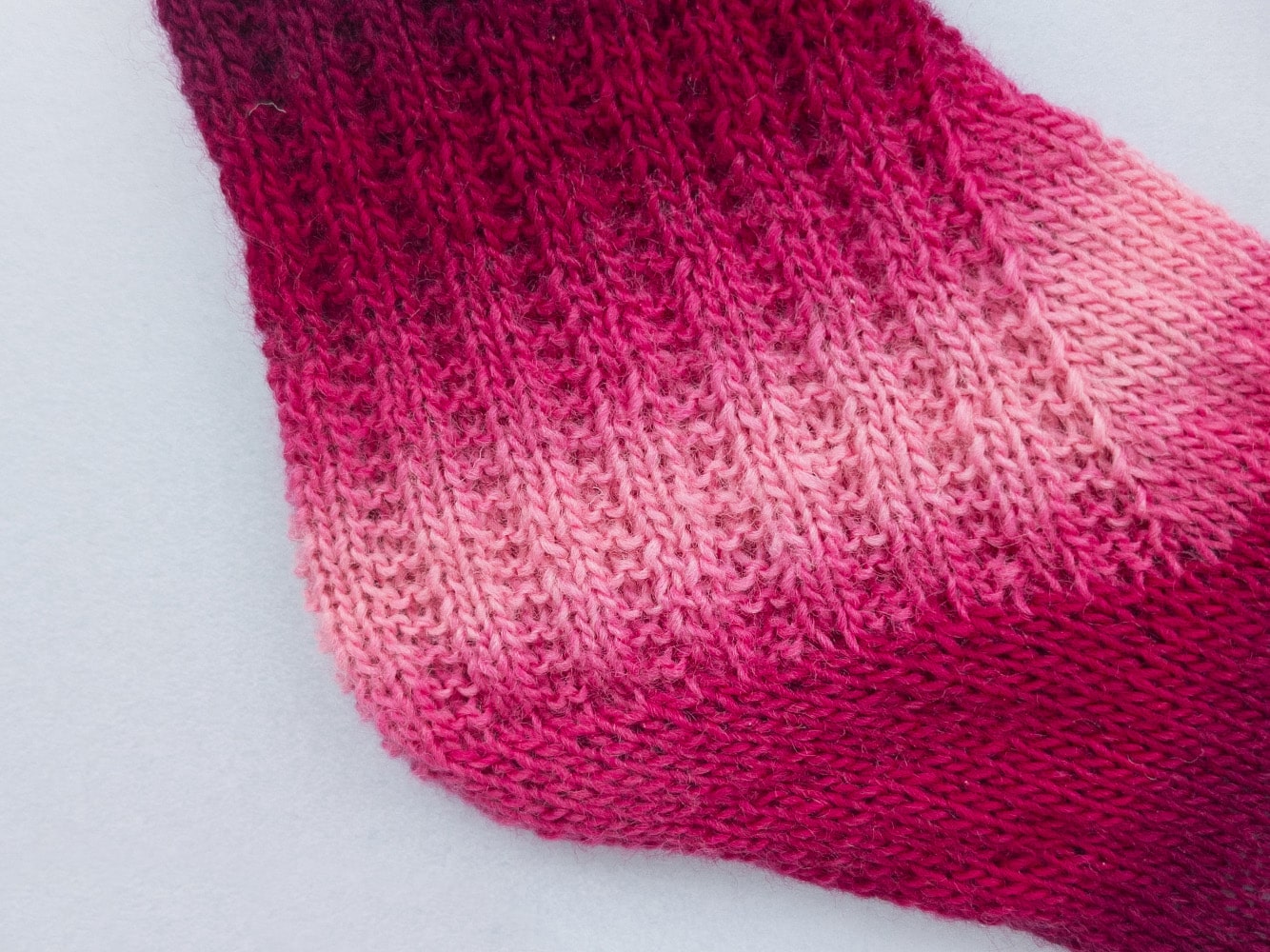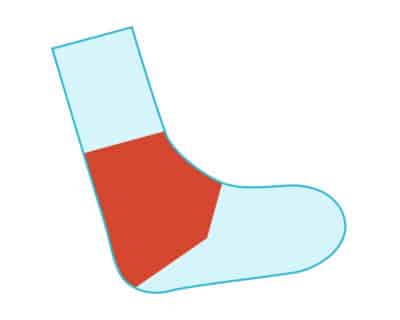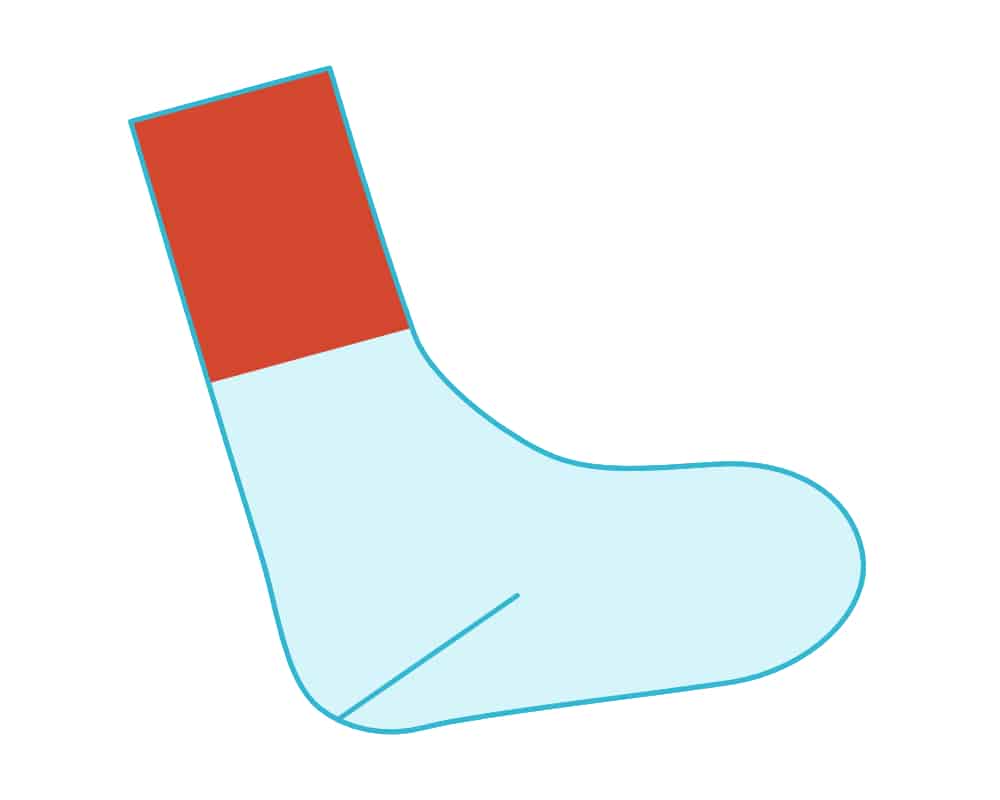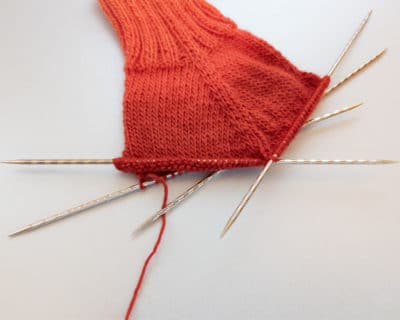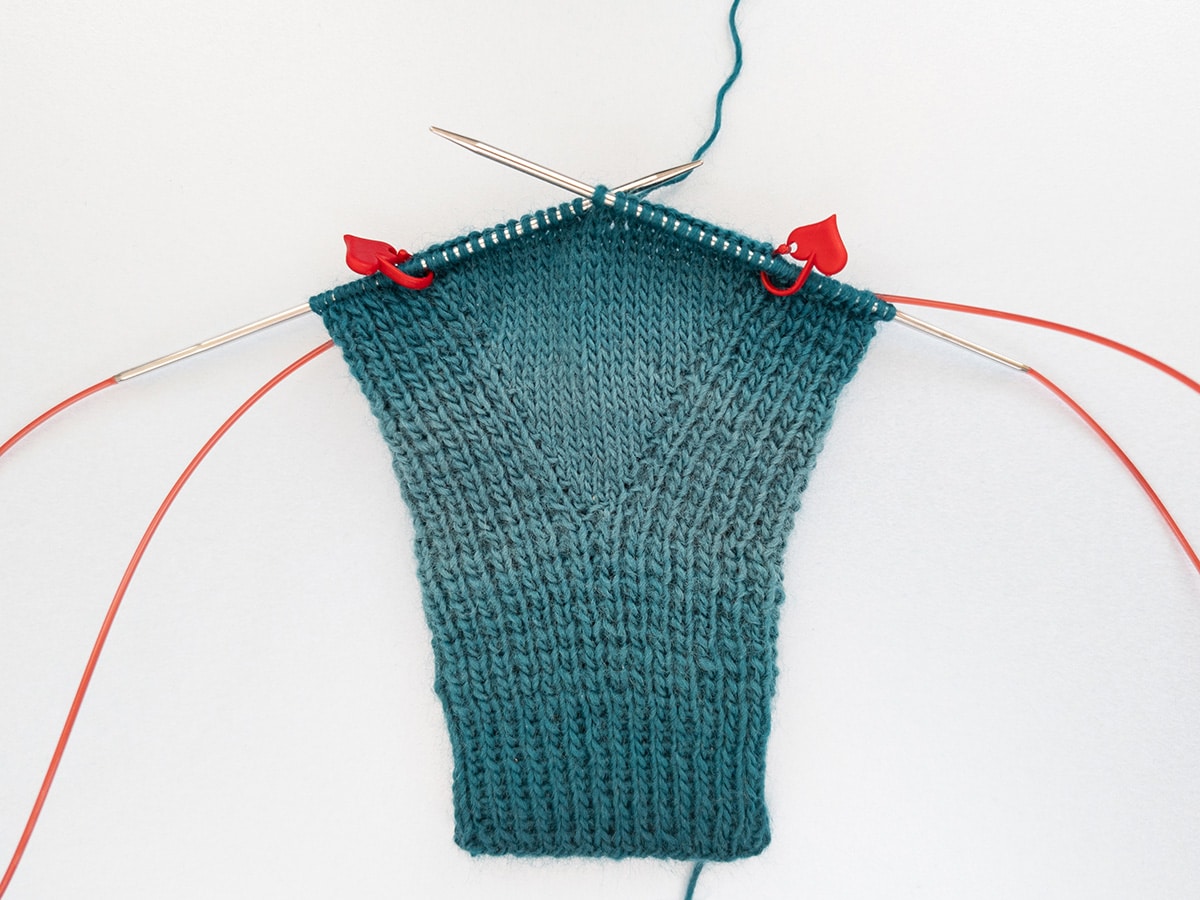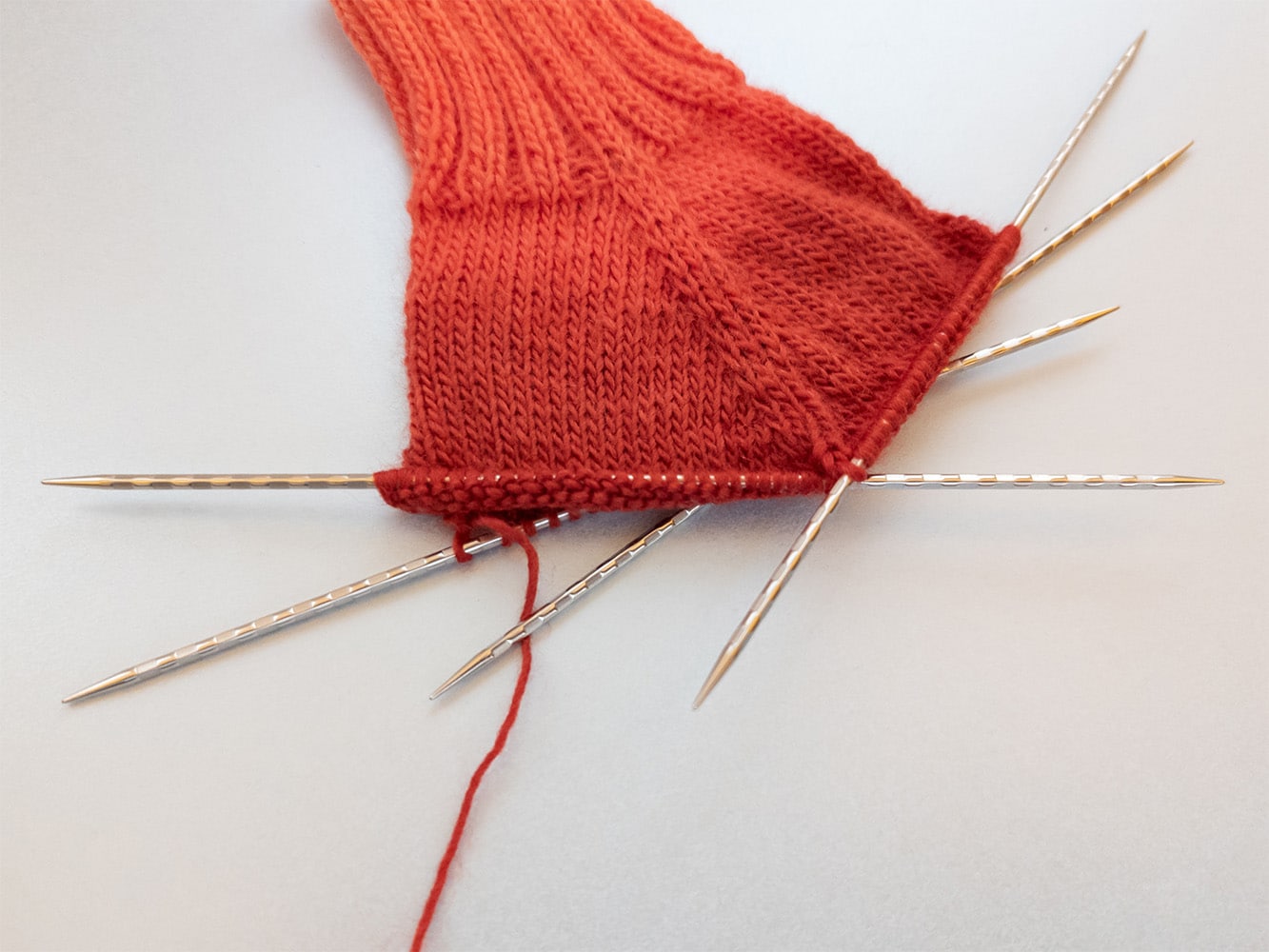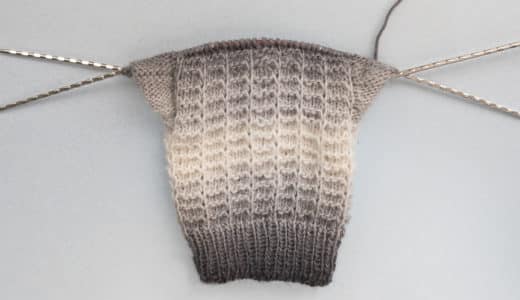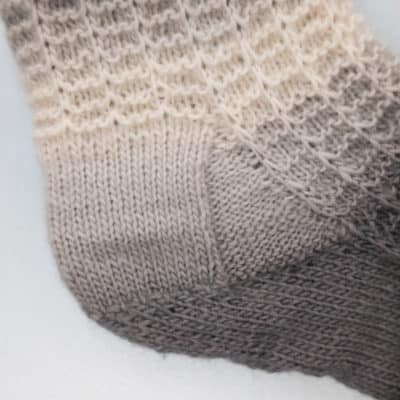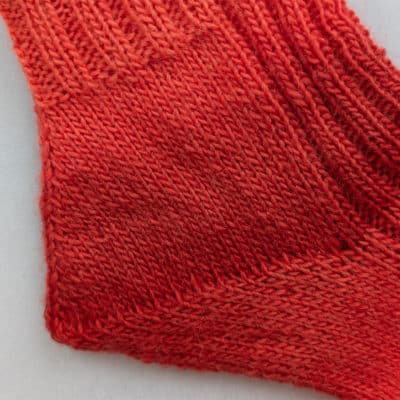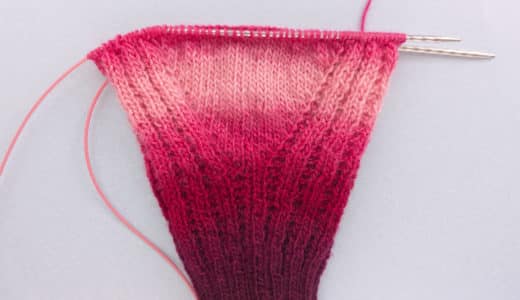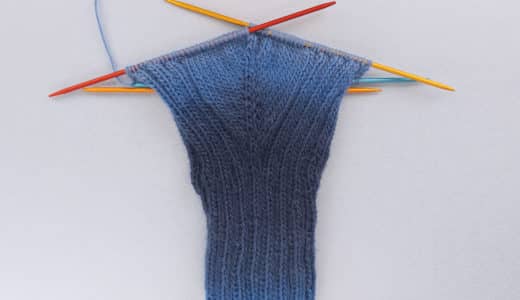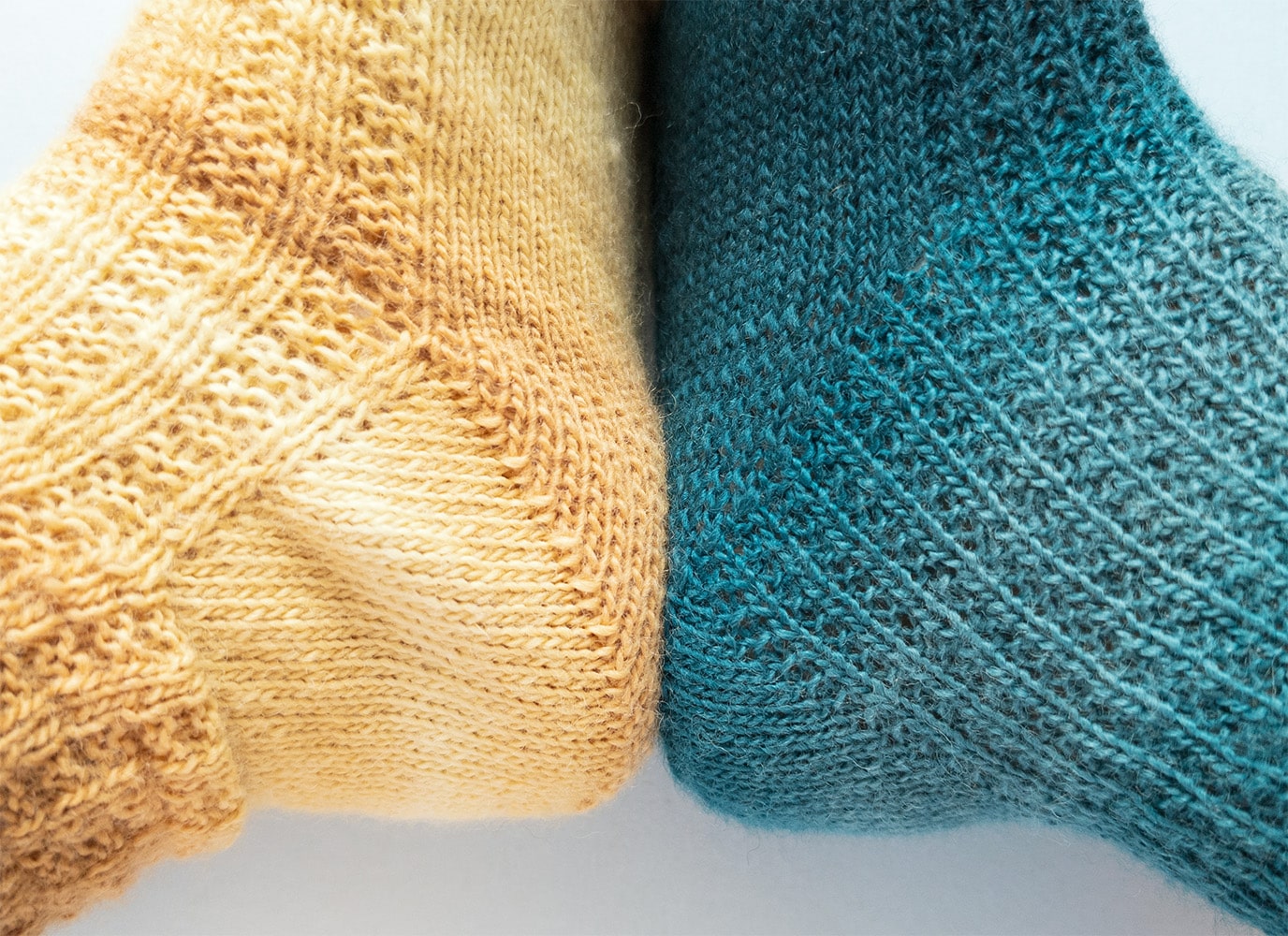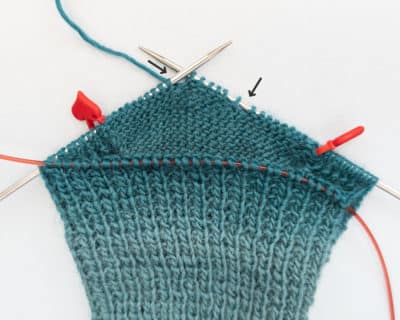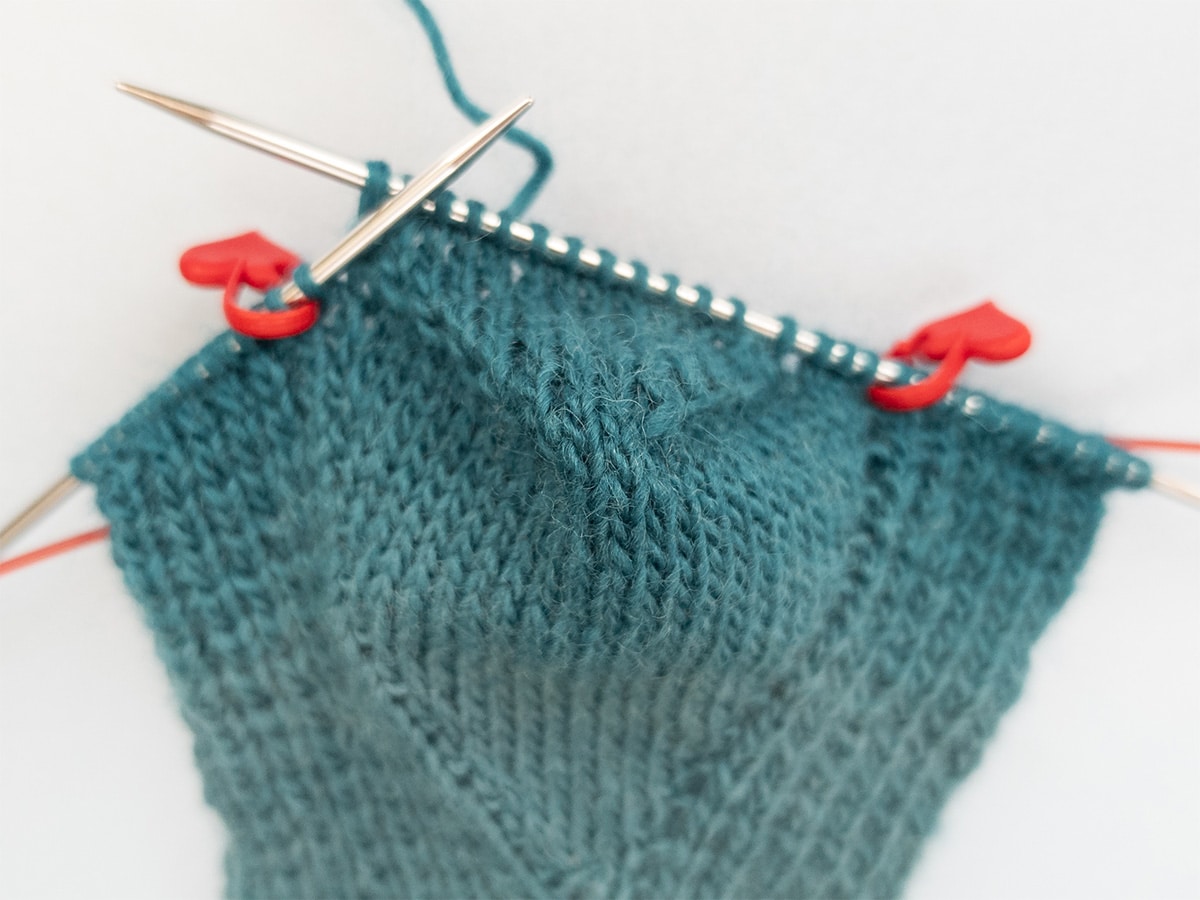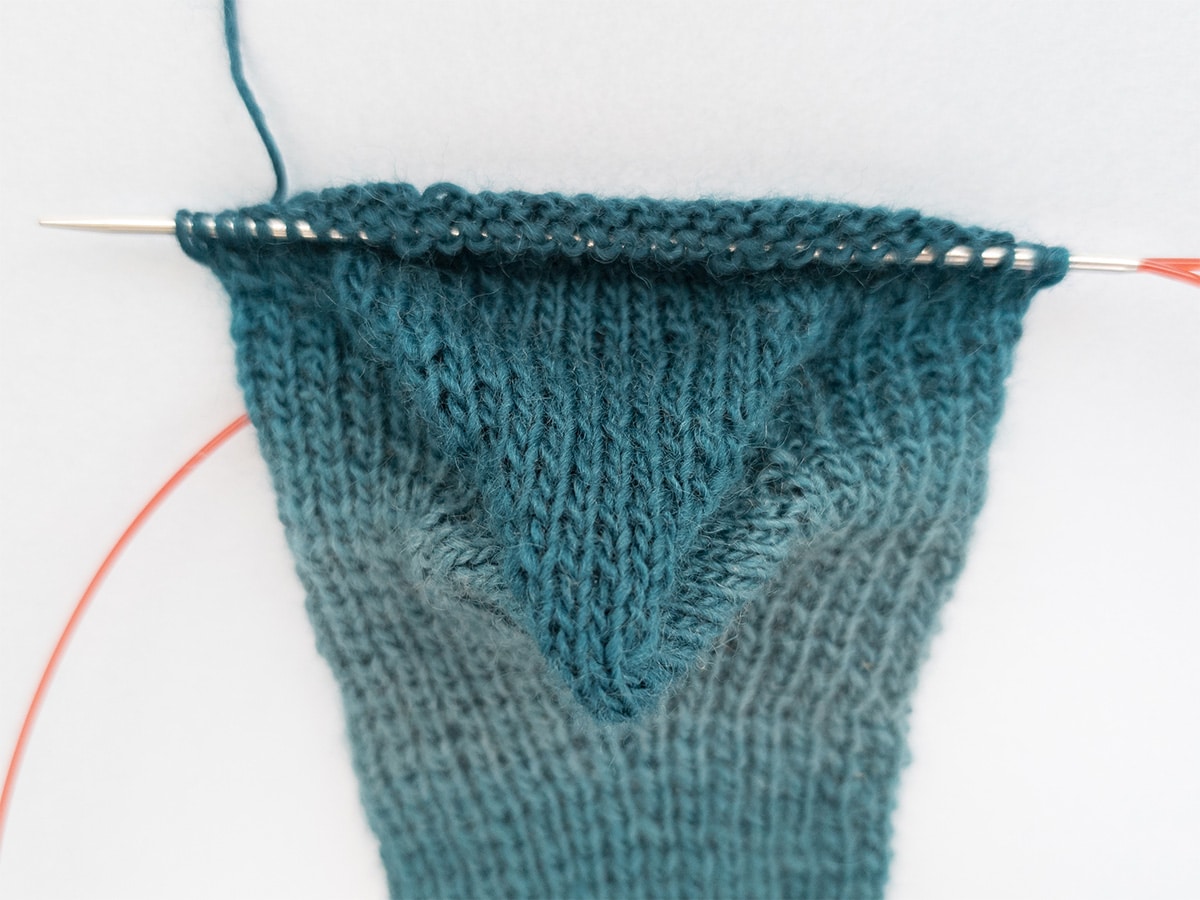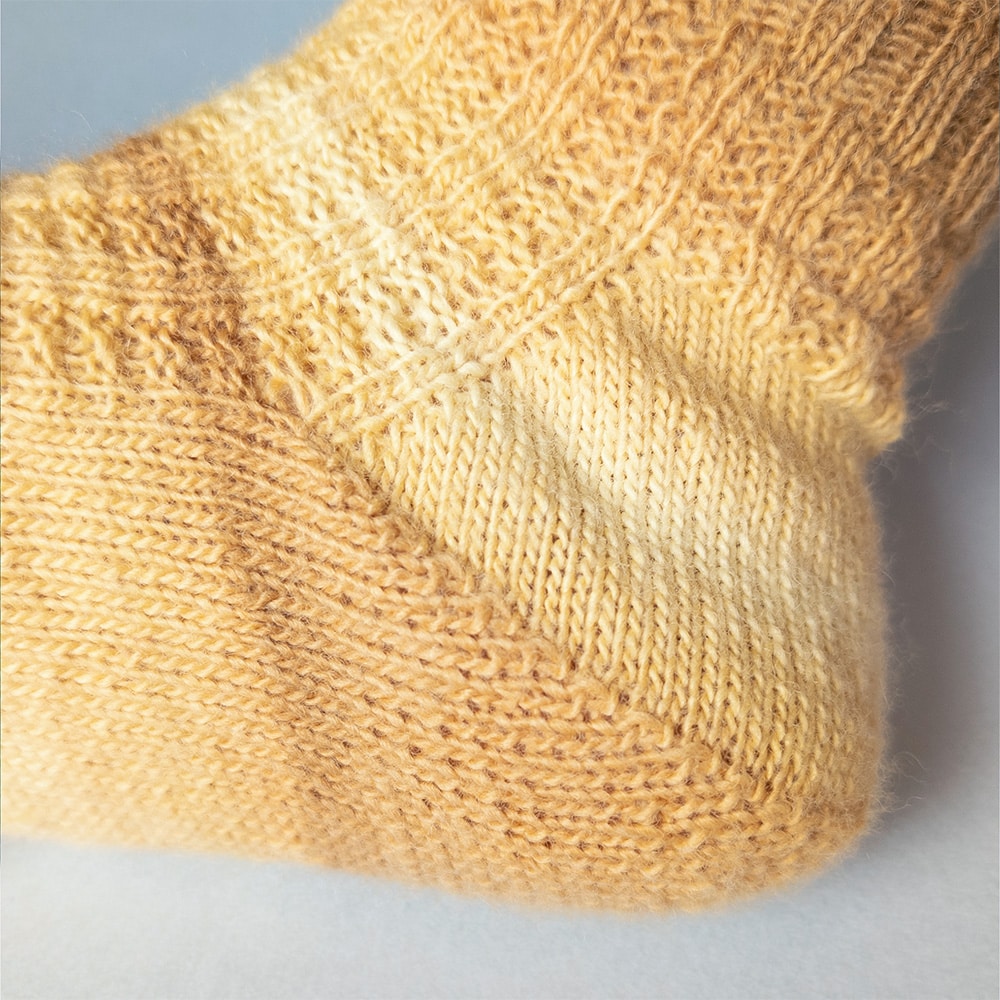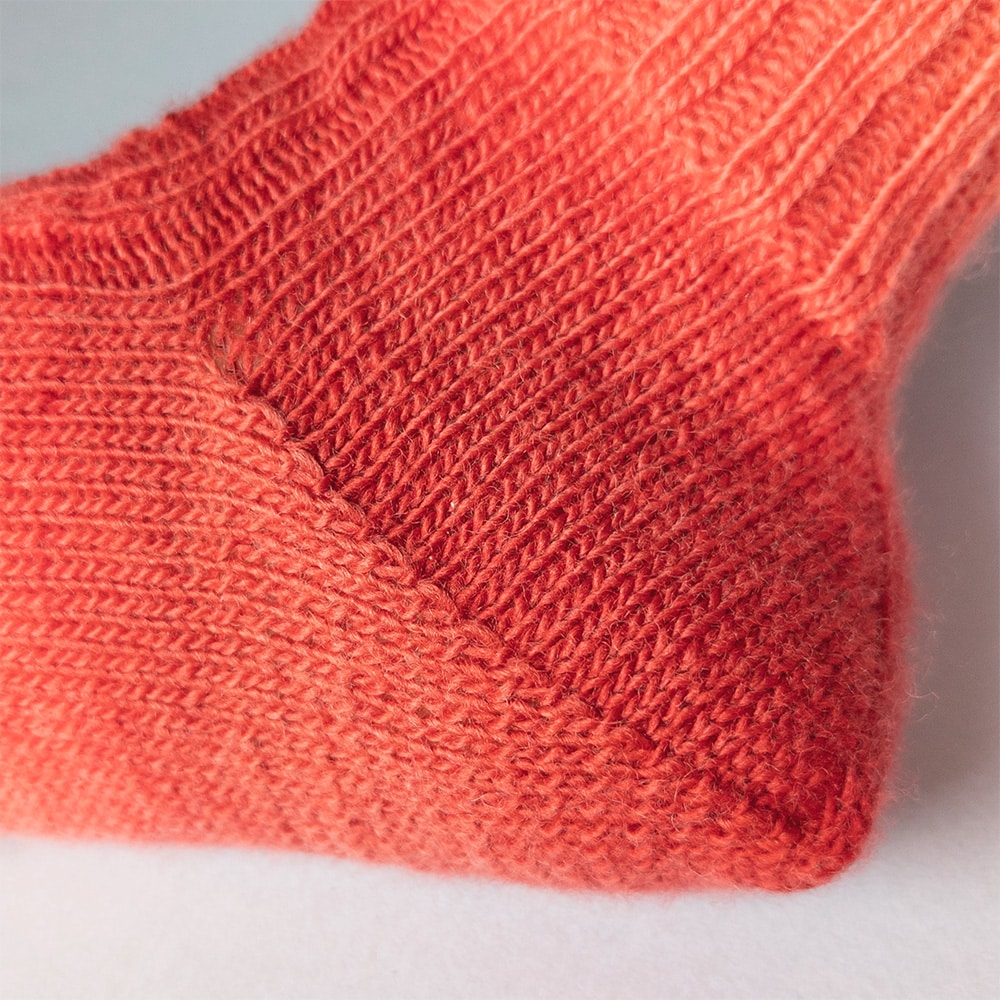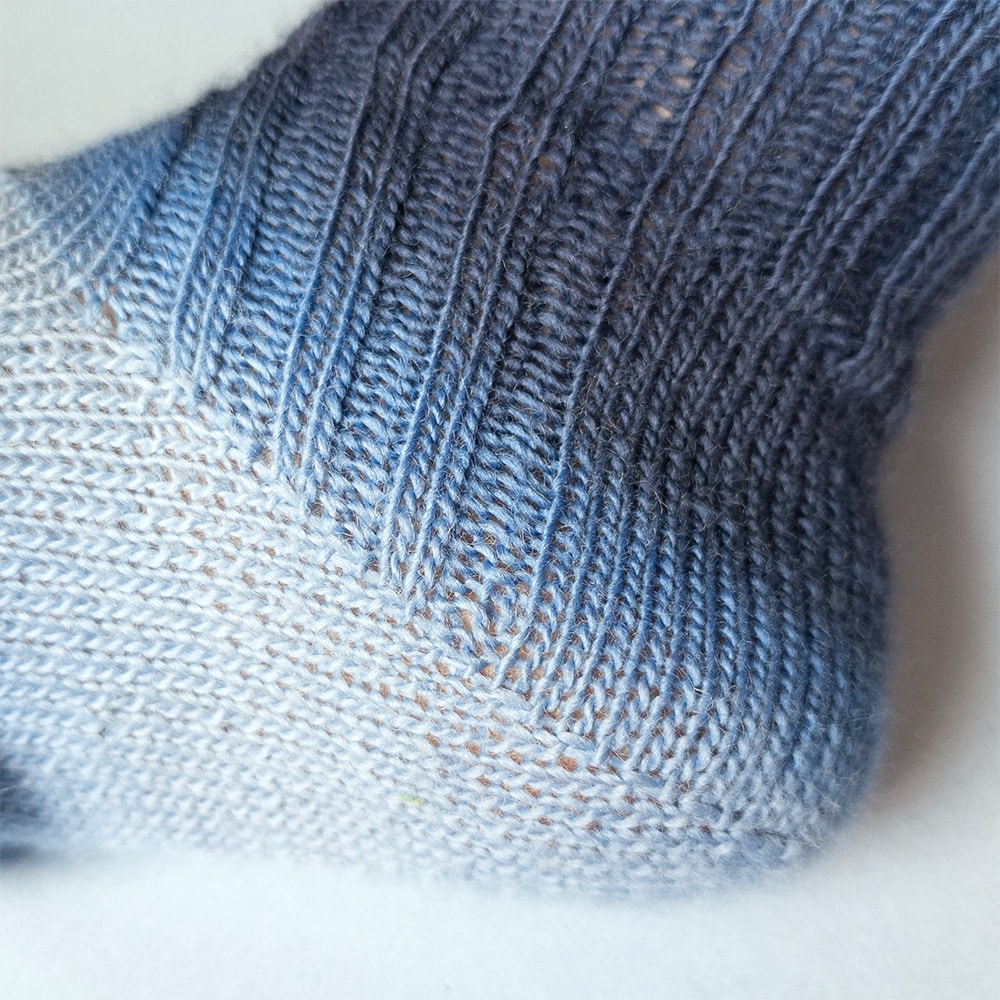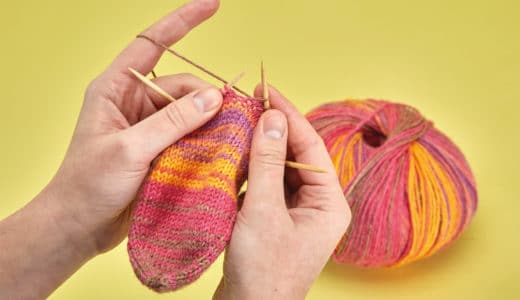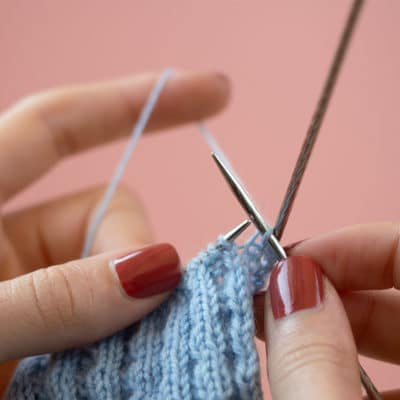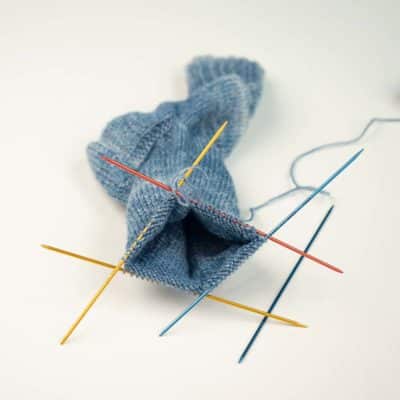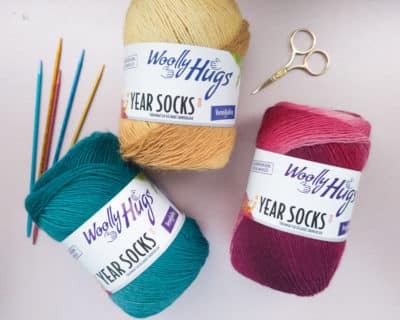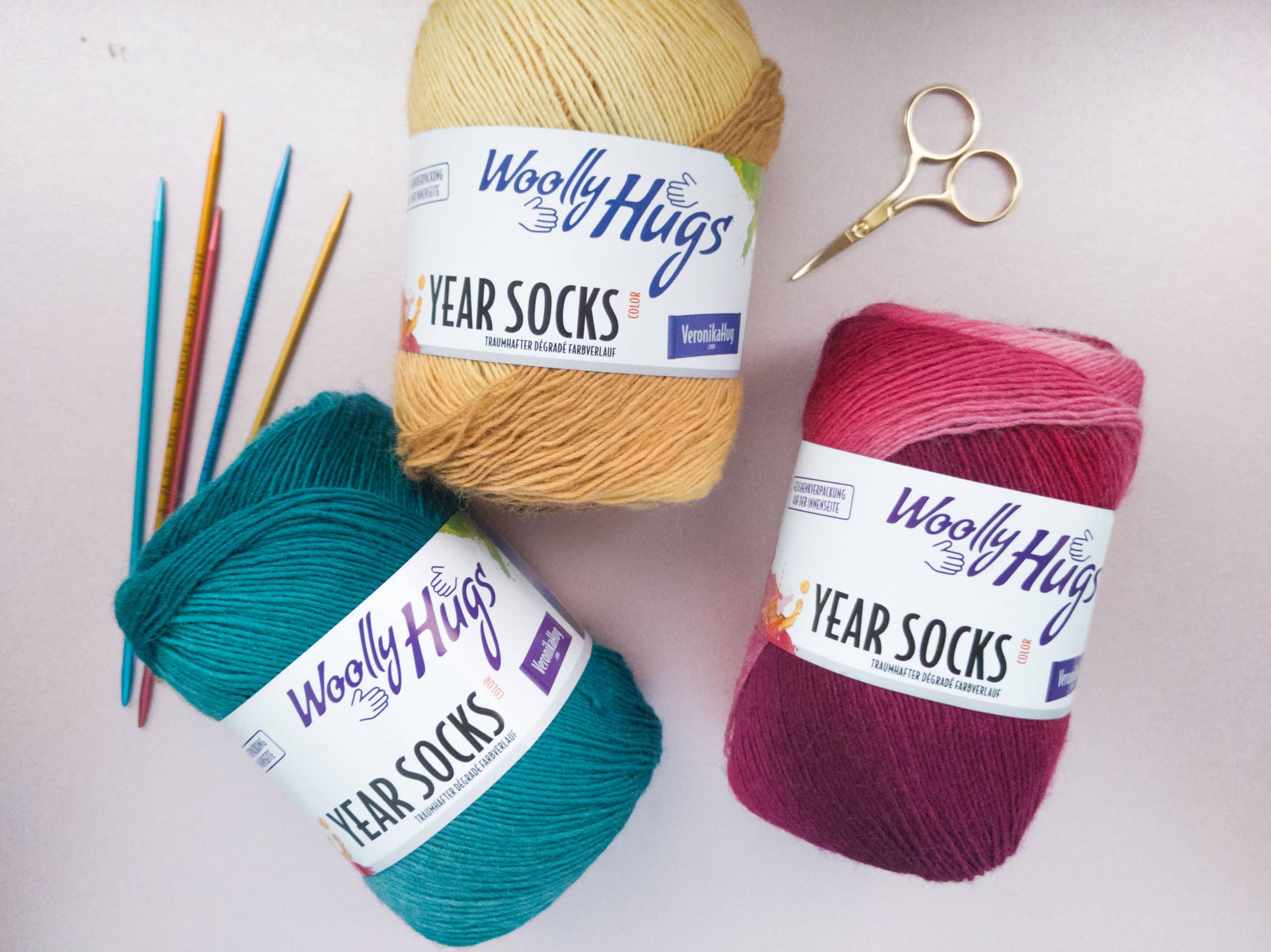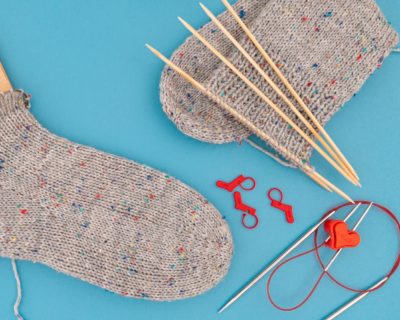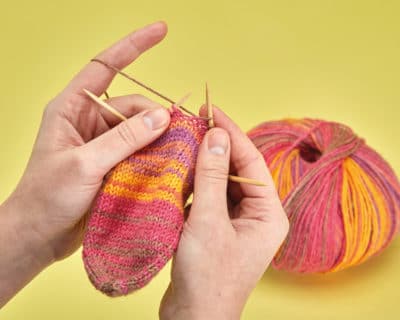Knit fleegle heel – top down with 6 variants
The fleegle heel is an easy-to-knit top-down heel and is shaped by increases in the shaft, before the stitches are worked under the heel with decrease rows to form a triangular cap.
In this tutorial, we describe step by step how to knit the increase heel in different variants – with addiCraSyTrio, double pointed needles or circular needles with a magic loop.
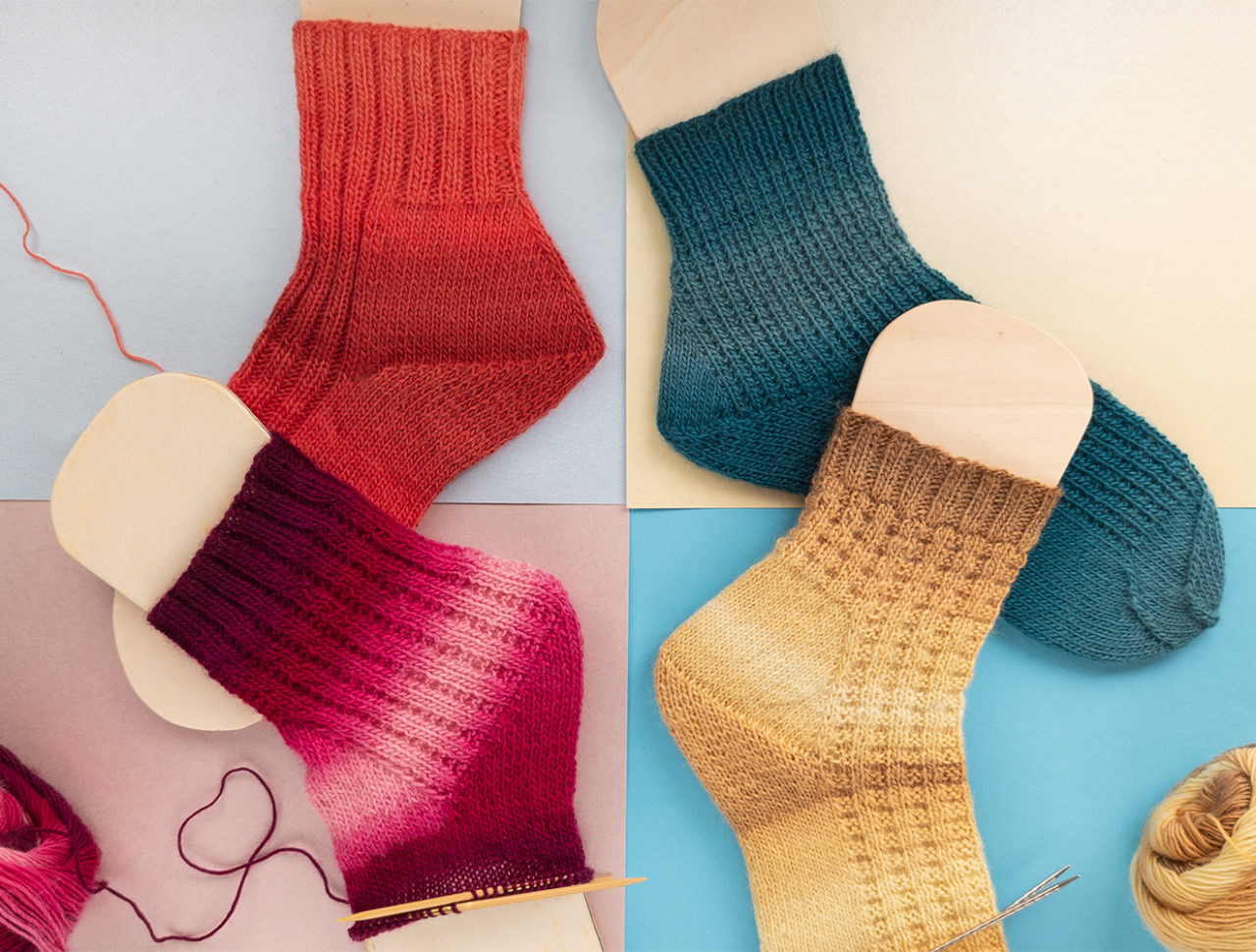
Features of the fleegle heel:
Foot instep height: ♥♥♥♥♡
Wide heel: ♥♥♥♥♡
Yarn consumption: Raised
Technique: ↓ Top-Down ↑ Toe-Up (different instructions)
Customizability: You can work more or fewer increases (e.g. work increases in each round at the end instead of every second round) to change the fit for a higher instep.
Usage: For striped patterns or yarns with patterns – these are not interrupted by the fleegle heel. For patterns that continue – beautiful accents are possible through different increase positions.
Not possible: Contrasting the heel – here, only the V-shaped heel turn can be contrasted.
Principle and variants of the fleegle heel
The increases can be worked at any point on the leg. Depending on the position, different effects can be achieved, which can be used to deliberately break up the leg pattern, for example, or to continue to the top of the foot (dotted line in the sketches).
The 6 possible variants look like this:
- The increases on the leg (which replace the gusset and heel flap of a classic heel) also create enough space for a higher instep and influence the look of the heel (see graphics).
- The following heel flap is always knitted the same way in rows with decreases and finishes the heel. This results in a side line (continuous red line in the sketches).
- Stitches do not have to be picked up at any point in the knitted fabric. All stitches remain on the needles.
The compatible needles
Due to the many increases that are worked, the fleegle heel should be knitted on longer needle such as
- with 20 cm/ 8" Double-pointed needles
- the addiCraSyTrio Long
- or as a magic loop on an 80 cm/ 32" circular knitting needle
Needles such as the addiSockwonder or addiCraSyTrio Short are too short for this type of heel.
How it works: Knitting the fleegle heel
Start the sock with your usual number of stitches and knit a cuff of your choice and a leg pattern of your choice.
Remember that the leg will be longer due to the following increasesection. Depending on the shoe size, the increase section for 4-ply sock yarn will be about:
- 4 cm/ 1.6" (Size EU 20/ UK JNR 5)
- 5 cm/ 2" (Size EU 28/ UK 10 JNR)
- 6 cm/ 2.4" (Size EU 36/ UK 3.5)
- 7 cm/ 2.8" (Size EU 42/ UK 8)
- 8,5 cm/ 3.4" (Size EU 48/ UK 12.5)
The concept: Für die Zunahmeferse wird der Schaft im unteren Teil durch Zunahmen immer weiter und formt einen Keil. Dieser dient als „Spickel und Fersenwand“. Je nach Schaftmuster kannst du dich nun für eine Position deiner Zunahmen entscheiden, die entweder im Schaftmuster (möglich bei Variante 1, 3, 4 und 6) oder beispielsweise glatt rechts oder kraus rechts abgesetzt werden kann (mit allen Variante möglich).
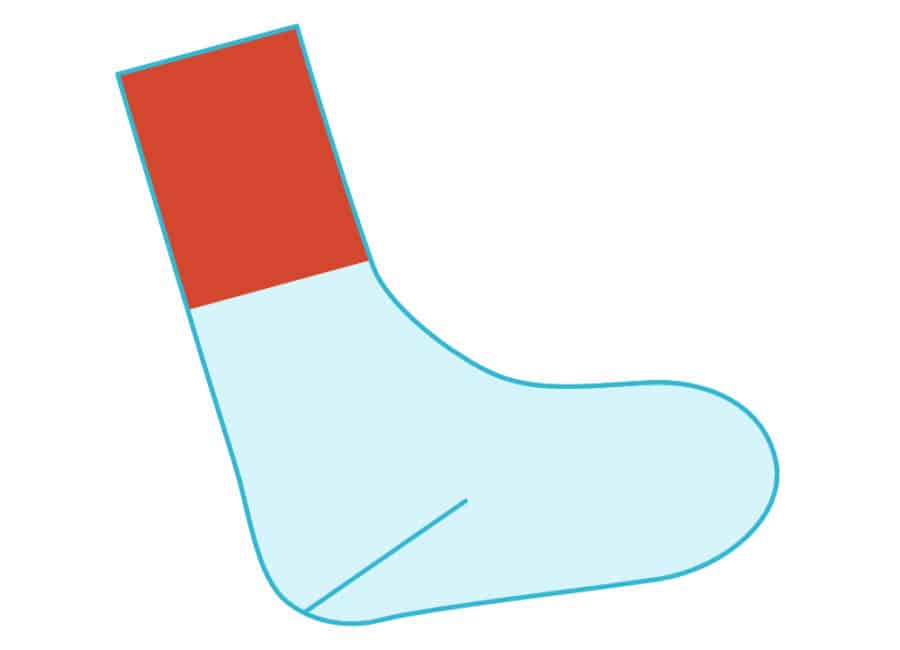

How it works: Knitting the fleegle heel
Start the sock with your usual number of stitches and knit a cuff of your choice and a leg pattern of your choice.
Remember that the leg will be longer due to the following increasesection. Depending on the shoe size, the increase section for 4-ply sock yarn will be about:
- 4 cm/ 1.6" (Size EU 20/ UK JNR 5)
- 5 cm/ 2" (Size EU 28/ UK 10 JNR)
- 6 cm/ 2.4" (Size EU 36/ UK 3.5)
- 7 cm/ 2.8" (Size EU 42/ UK 8)
- 8,5 cm/ 3.4" (Size EU 48/ UK 12.5)
The concept: Für die Zunahmeferse wird der Schaft im unteren Teil durch Zunahmen immer weiter und formt einen Keil. Dieser dient als „Spickel und Fersenwand“. Je nach Schaftmuster kannst du dich nun für eine Position deiner Zunahmen entscheiden, die entweder im Schaftmuster (möglich bei Variante 1, 3, 4 und 6) oder beispielsweise glatt rechts oder kraus rechts abgesetzt werden kann (mit allen Variante möglich).
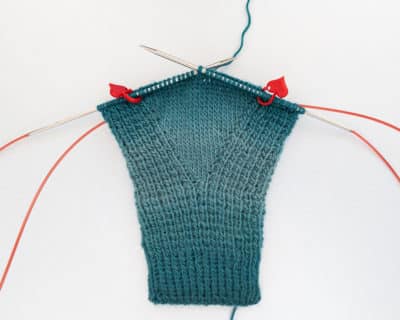
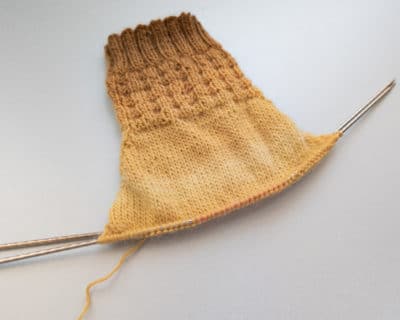
Basics for the fleegle heel
There will always alternately be a round of increases and a round without increases. For the increases, work in a technique of your choice, e.g. with increases worked from a lower stitch or KFB (KFB = knit front and back).
Formula for the number of increase rounds: Number of heel stitches (half of cast on) minus 2 stitches.
So, for example, 28 rounds are worked with 28 increases (one round with 2 increases, one round without increases).
The usual sizes and yarns are shown in the chart below. Where exactly the increase is knitted differs depending on the variant desired. All variants are shown below.
Double pointed needles: The increases are knitted over 2 needles, depending on the variant. The stitches are NOT placed on a needle here (as with other heels), as they are still knitted in the round. The other two needles are knitted according to the pattern. The heel is worked over needles 4 and 1.
addiCraSyTrio/ FlexiFlips: Depending on the variation, the increases are knitted on one needle, the second needle is knitted in the round according to the pattern.
Magic Loop: Depending on the variation, the heel is knitted over one half of the stitches, the second half is knitted in the round according to the pattern.

Basics for the fleegle heel
There will always alternately be a round of increases and a round without increases. For the increases, work in a technique of your choice, e.g. with increases worked from a lower stitch or KFB (KFB = knit front and back).
Formula for the number of increase rounds: Number of heel stitches (half of cast on) minus 2 stitches.
So, for example, 28 rounds are worked with 28 increases (one round with 2 increases, one round without increases).
The usual sizes and yarns are shown in the chart below. Where exactly the increase is knitted differs depending on the variant desired. All variants are shown below.
Double pointed needles: The increases are knitted over 2 needles, depending on the variant. The stitches are NOT placed on a needle here (as with other heels), as they are still knitted in the round. The other two needles are knitted according to the pattern. The heel is worked over needles 4 and 1.
addiCraSyTrio/ FlexiFlips: Depending on the variation, the increases are knitted on one needle, the second needle is knitted in the round according to the pattern.
Magic Loop: Depending on the variation, the heel is knitted over one half of the stitches, the second half is knitted in the round according to the pattern.
Sock charts top down for fleegle heel
(from the cuff to the toe)
Sock chart Top-Down 4-ply:
- Sock wool 4‐ply (420m, 100g) (384 yd, 3.5 oz)
- for Needle size 2,5-3 mm / US 1-2
- Gauge: 30 stitches/ 42 rows = 4″x4″ (10×10 cm)
| Shoe size EU | 17/18 | 19/20 | 20/21 | 22/23 | 24/25 | 26/27 | 28/29 | 30/31 | 32/33 | 34/35 | 36/37 | 38/39 | 40/41 | 42/43 | 44/45 | 46/47 | 48/49 |
| Shoe size UK |
3-4 JNR |
2½-3 JNR |
5-6 JNR | 5½-6 JNR |
7-8 JNR |
8½-9½ JNR |
10-11 JNR |
1½-12½ JNR |
1 | 2-2½ |
3½-4½ | 5-6 | 6½-7½ | 8-9 |
9½-10½ | 9½-10½ | 12½-13½ |
| Stitches total CO | 36 | 36 | 40 | 40 | 44 | 48 | 48 | 52 | 52 | 56 | 56 | 60 | 60 | 64 | 68 | 72 | 76 |
| Sts per needle addiCraSyTrio | 18 | 18 | 20 | 20 | 22 | 24 | 24 | 26 | 26 | 28 | 28 | 30 | 30 | 32 | 34 | 36 | 38 |
| Sts per needle dpn | 9 | 9 | 10 | 10 | 11 | 12 | 12 | 13 | 13 | 14 | 14 | 15 | 15 | 16 | 17 | 18 | 19 |
| Sts for heel | 18 | 18 | 20 | 20 | 22 | 24 | 24 | 26 | 26 | 28 | 28 | 30 | 30 | 32 | 34 | 36 | 38 |
| Fleegle heel: |
|||||||||||||||||
| Increases in total on both sides | 16 | 16 | 18 | 18 | 20 | 22 | 22 | 24 | 24 | 26 | 26 | 28 | 28 | 30 | 32 | 34 | 36 |
| Felegle heel Total inc. rounds (inc., & interm. rd) | 16 | 16 | 18 | 18 | 20 | 22 | 22 | 24 | 24 | 26 | 26 | 28 | 28 | 30 | 32 | 34 | 36 |
Sock chart Top-Down 6-ply:
- Sock wool 6‐ply (380m, 150g) (347 yd, 5.3 oz)
- for Needle size 3-4 mm / US 2-6
- Gauge: 22 stitches/ 30 rows = 4″x4″ (10×10 cm)
| Shoe size EU | 17/18 | 19/20 | 20/21 | 22/23 | 24/25 | 26/27 | 28/29 | 30/31 | 32/33 | 34/35 | 36/37 | 38/39 | 40/41 | 42/43 | 44/45 | 46/47 | 48/49 |
| Shoe size UK | 3-4 JNR | 2½-3 JNR |
5-6 JNR | 5½-6 JNR |
7-8 JNR |
8½-9½ JNR |
10-11 JNR |
11½-12½ JNR |
1 | 2-2½ | 3½-4½ | 5-6 | 6½-7½ | 8-9 | 9½-10½ | 11-12 | 12½-13½ |
| Stitches total CO | 28 | 28 | 32 | 32 | 36 | 36 | 40 | 40 | 44 | 44 | 48 | 48 | 52 | 52 | 56 | 56 | 60 |
| Sts per needle addiCraSyTrio | 14 | 14 | 16 | 16 | 18 | 18 | 20 | 20 | 22 | 22 | 24 | 24 | 26 | 26 | 28 | 28 | 30 |
| Sts per needle dpn | 7 | 7 | 8 | 8 | 9 | 9 | 10 | 10 | 11 | 11 | 12 | 12 | 13 | 13 | 14 | 14 | 15 |
| Sts for heel | 14 | 14 | 16 | 16 | 18 | 18 | 20 | 20 | 22 | 22 | 24 | 24 | 26 | 26 | 28 | 36 | 38 |
| Fleegle heel | |||||||||||||||||
| Total increases on both sides | 12 | 12 | 14 | 14 | 16 | 16 | 18 | 18 | 20 | 20 | 22 | 22 | 24 | 24 | 26 | 26 | 28 |
| Felegle heel Total inc. rounds (inc., & interm. rd) | 12 | 12 | 14 | 14 | 16 | 16 | 18 | 18 | 20 | 20 | 22 | 22 | 24 | 24 | 26 | 26 | 28 |
Sock chart Top-Down 8-ply:
- Sock wool 8‐ply (300m, 150g) (274 yd, 5.3 oz)
- for Needle size 4-5 mm / US 6-8
- Gauge: 20 stitches/ 28 rows = 4″x4″ (10×10 cm)
| Shoe size EU | 17/18 | 19/20 | 20/21 | 22/23 | 24/25 | 26/27 | 28/29 | 30/31 | 32/33 | 34/35 | 36/37 | 38/39 | 40/41 | 42/43 | 44/45 | 46/47 | 48/49 |
| Shoe size UK | 3-4 JNR | 2½-3 JNR |
4-5 JNR | 5½-6 JNR |
7-8 JNR |
8½-9½ JNR |
10-11 JNR |
11½-12½ JNR |
1 | 2-2½ |
3½-4½ | 5-6 | 6½-7½ | 8-9 |
9½-10½ | 11-12 |
12½-13½ |
| Stitches total CO | 24 | 24 | 28 | 28 | 32 | 32 | 36 | 36 | 40 | 40 | 44 | 44 | 48 | 48 | 52 | 52 | 56 |
| Sts per needle addiCraSyTrio | 12 | 12 | 14 | 14 | 16 | 16 | 18 | 18 | 20 | 20 | 22 | 22 | 24 | 24 | 26 | 26 | 28 |
| Sts per needle dpn | 6 | 6 | 7 | 7 | 8 | 8 | 9 | 9 | 10 | 10 | 11 | 11 | 12 | 12 | 13 | 13 | 14 |
| Sts for heel | 12 | 12 | 14 | 14 | 16 | 16 | 18 | 18 | 20 | 20 | 22 | 22 | 24 | 24 | 26 | 26 | 28 |
| Fleegle heel | |||||||||||||||||
| Total increases on both sides | 10 | 10 | 12 | 12 | 14 | 14 | 16 | 16 | 18 | 18 | 20 | 20 | 22 | 22 | 24 | 24 | 26 |
| Felegle heel Total inc. rounds (inc., & interm. rd) |
10 | 10 | 12 | 12 | 14 | 14 | 16 | 16 | 18 | 18 | 20 | 20 | 22 | 22 | 24 | 24 | 26 |
Knit the increases
You should now have determined the required number of increases for your shoe size and just need to decide on a position for the increases. You're ready to go.
Depending on the variant, the places for the increases are either at the beginning and end of the needle(s) or in the centre. To mark the place, 1-2 stitch markers can be used.
Tip: The fleegle heel allows countless pattern combinations - the front and back can continue to be knitted in leg pattern or, for example, stockinette stitch at the heel. The increase wedges can also be worked stockinette, garter stitch, in ribs or in the pattern of the foot.
An overview of all fleegle heel variants here:
Adjustments to the instep
For a lower or higher instep, the increases can be adjusted as follows:
For a low instep - fewer increases (with the same number of rounds) e.g. only increase every third round for the first few increases
For a high instep - more increases (with the same number of rounds) e.g. work the last rounds of increases every round
Finish the fleegle heel with the wedge-shaped heel turn
All variations of the fleegle heel require increases and rounds of increases. Once these have been completed, the next round is finished exactly in the centre of the heel:
- Double pointed needles: between needle 4 and 1
- addiCraSyTrio/ FlexiFlips: centre of the back needle
- Magic Loop: centre of the heel stitches
For all variants where the increases are on the front half of the sock: Here, the outer stitches of the front side (in the number of increases knitted) are now placed on the back needle(s) to be reduced again - evenly on both outer sides of the needle(s) to the right and left of the heel stitches.
The concept: The heel is shaped and finished with the triangular heel turn. To do this, the number of stitches increased (regardless of where in the sock) is now reduced to the original number of stitches in the centre of the back of the heel by turning repeatedly and the end of the heel is formed.


Finish the fleegle heel with the wedge-shaped heel turn
All variations of the fleegle heel require increases and rounds of increases. Once these have been completed, the next round is finished exactly in the centre of the heel:
- Double pointed needles: between needle 4 and 1
- addiCraSyTrio/ FlexiFlips: centre of the back needle
- Magic Loop: centre of the heel stitches
For all variants where the increases are on the front half of the sock: Here, the outer stitches of the front side (in the number of increases knitted) are now placed on the back needle(s) to be reduced again - evenly on both outer sides of the needle(s) to the right and left of the heel stitches.
The concept: The heel is shaped and finished with the triangular heel turn. To do this, the number of stitches increased (regardless of where in the sock) is now reduced to the original number of stitches in the centre of the back of the heel by turning repeatedly and the end of the heel is formed.
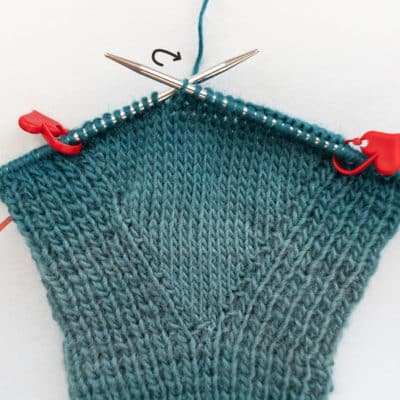
Knit heel turns
The heel turn is now knitted in rows and starts in the centre of the heel (Trio and Magig Loop in the centre of needle two, double pointed needles between needle 4 and 1):
- Right Side (row 1): from the centre of the heel, k1, k2tog (slip 1, k1, slip the first sts over the second), k1, turn work (photo 1)
- Wrong Side (row 2): slip 1 purlwise, p3, p2tog, p1, turn work
There are now two gaps to the left and right of the middle stitches (photo 2), which are closed in the next right and wrong side by decrease the stitches in front of and behind the gap.
- Right Side (row 3):: slip 1 purlwise, k4 , slip and psso (the stitches before and after the gap, see row 1), k1, turn
- Wrong Side (row 4):: slip 1 purlwise, p5, p2tog (the stitches before and after the gap), p1, turn
- Right Side (row 5):: slip 1 purlwise, k6, slip and psso (the stitches before and after the gap, see row 1), k1, turn
- Wrong Side (row 6):: slip 1 purlwise, p7, p2tog (the stitches before and after the gap), p1, turn
The rows are repeated continuously. Knit or purl 1 stitch more in each row, see underlined number, until all heel stitches have been worked
Tip: If you don't want to count, take note of the gaps and knit the stitch BEFORE the gap together with the stitch BEHIND the gap.

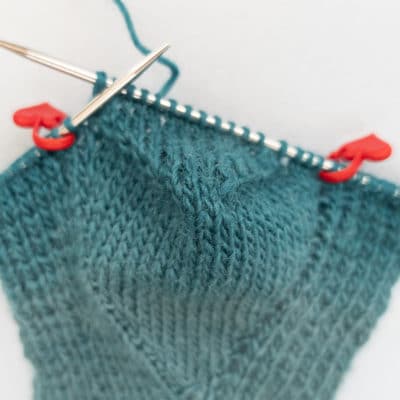
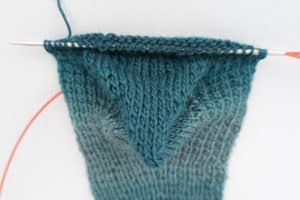
Knit heel turns
The heel turn is now knitted in rows and starts in the centre of the heel (Trio and Magig Loop in the centre of needle two, double pointed needles between needle 4 and 1):
- Right Side (row 1): from the centre of the heel, k1, k2tog (slip 1, k1, slip the first sts over the second), k1, turn work (photo 1)
- Wrong Side (row 2): slip 1 purlwise, p3, p2tog, p1, turn work
There are now two gaps to the left and right of the middle stitches (photo 2), which are closed in the next right and wrong side by decrease the stitches in front of and behind the gap.
- Right Side (row 3):: slip 1 purlwise, k4 , slip and psso (the stitches before and after the gap, see row 1), k1, turn
- Wrong Side (row 4):: slip 1 purlwise, p5, p2tog (the stitches before and after the gap), p1, turn
- Right Side (row 5):: slip 1 purlwise, k6, slip and psso (the stitches before and after the gap, see row 1), k1, turn
- Wrong Side (row 6):: slip 1 purlwise, p7, p2tog (the stitches before and after the gap), p1, turn
The rows are repeated continuously. Knit or purl 1 stitch more in each row, see underlined number, until all heel stitches have been worked
Tip: If you don't want to count, take note of the gaps and knit the stitch BEFORE the gap together with the stitch BEHIND the gap.
Short form heel turn knitting for professionals:
- Row 1 (RS): 2M überz zsm, 1M re, wenden
- Row 2 (WS): 1M li abh, 1M li, 2M li zsm, wenden
- Row 3 (RS): 1M li abheben, 2M re, 2M überz zus, 1M re, wenden
- Row 4 (WS): 1M li abheben, 3M li, 2M li zsm, wenden
- Row 5 (RS): 1M li abheben, 4M re, 2M überz zus, 1M re, wenden
- Row 6 (WS): 1M li abheben, 5M li, 2M li zsm, wenden
- Row 7 (RS): 1M li abheben, 6M re, 2M überz zus, 1M re, wenden
- Row 8 (WS): 1M li abheben, 7M li, 2M li zsm, wenden
Repeat with 1 more stitch until the original number of sts is reached again.
There should now be as many stitches on the needles as were originally cast on. This completes the fleegle heel.
From now on, we knit in the round again and continue with the foot section in our basic sock pattern.
Basic tutorial for socks
Vidoe tutorial by CraSy Sylvie (german)
Variant 2 with side increases at the back, knitted with double pointed needles is also available as video explained by Sylvie Rasch.
addi knitting needles for socks
The socks in this tutorial were made with the 4-ply sock yarn Woolly Hugs Year Socks .


